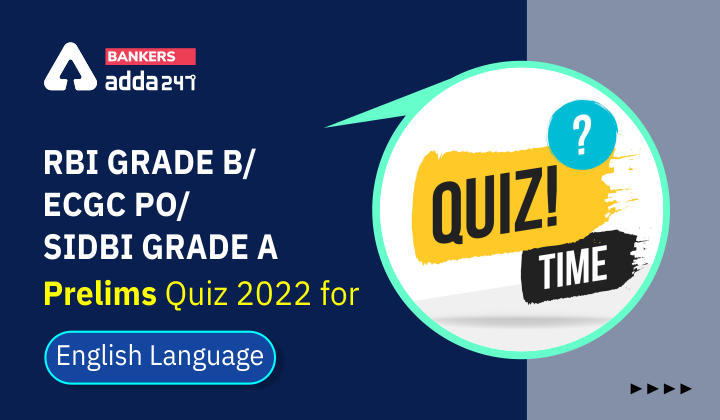
Directions (1-15): In the questions given
below two sentences are given which are grammatically correct and meaningful.
Connect them with the most suitable word given below the statements in the best
possible way without changing the intended meaning. Choose your answer
accordingly from the options to form a correct, coherent sentence.
Q1.
(I) The
alarm goes off.
(II) I hit the snooze button.
(a) in addition
(b) nevertheless
(c) as soon as
(d) actually
(e) namely
S1. Ans. (c)
Sol. Among the given statements, only “As soon
as” can be used to connect the given statements.
The correct statement thus formed will be: As
soon as the alarm goes off, I hit the snooze button.
Q2.
(I) We were driving through the Lake District.
(II) We saw many picturesque villages.
(a) in brief
(b) at first
(c) therefore
(d)
however
(e) while
Sol. Among the given statements, only “while”
can be used to connect the given statements.
The correct statement thus formed will be: While
we were driving through the Lake District, we saw many picturesque villages.
Q3.
(I) This is Jimmy’s new bike.
(II) He got from his parents.
(a)
because
(b) similarly
(c) although
(d) which
(e) furthermore
S3. Ans. (d)
Sol. Among the given statements, only “which”
can be used to connect the given statements.
The correct statement thus formed will be: This
is Jimmy’s new bike, which he got from his parents.
Q4.
(I) I don’t want to go to the movies.
(II) I hate the smell of popcorn.
(a) because
(b) in
comparison
(c) despite
this
(d) notably
(e) consequently
S4. Ans. (a)
Sol. Among the given statements, only “because”
can be used to connect the given statements.
The correct statement thus formed will be: I
don’t want to go to the movies because I hate the smell of popcorn.
Q5.
(I) This cell phone tariff costs 8 cents per
minute.
(II) The other one offers a flat rate.
(a) while
(b) next
(c) especially
(d) thus
(e) illustrated
by
S5. Ans. (a)
Sol. Among the given statements, only “while”
can be used to connect the given statements.
The correct statement thus formed will be: This
cell phone tariff costs 8 cents per minute, while the other one offers a
flat rate.
Q6.
(I) We hadn’t eaten for over twelve hours.
(II) We weren’t very hungry.
(a) and
(b) although
(c) comparable
(d) accordingly
(e) yet
S6. Ans. (b)
Sol. Among the given statements, only “although”
can be used to connect the given statements.
The correct statement thus formed will be: Although
we hadn’t eaten for over twelve hours, we weren’t very hungry.
Q7.
(I) Martha wanted to work in England.
(II) She studied English hard.
(a) namely
(b) particularly
(c) therefore
(d) yet
(e) in the same breath
S7. Ans. (c)
Sol. Among the given statements, only “therefore”
can be used to connect the given statements.
The correct statement thus formed will be:
Martha wanted to work in England, therefore, she studied English hard.
Q8.
(I) You better keep quiet.
(II) You will be sent outside.
(a) on the contrary
(b) provided
(c) furthermore
(d) otherwise
(e) in summary
S8. Ans. (d)
Sol. Among the given statements, only
“otherwise” can be used to connect the given statements.
The correct statement thus formed will be: You
better keep quiet otherwise you will be sent outside
Q9.
(I) This is the village.
(II) I lived in my childhood.
(a) where
(b) with regard to
(c) while
(d) evidently
(e) as a result
S9. Ans. (a)
Sol. Among the given statements, only “where”
can be used to connect the given statements.
The correct statement thus formed will be: This
is the village where I lived in my childhood.
Q10.
(I) The office is closed for the next two days.
(II) You can still phone to leave a message.
(a) overall
(b) for the
most part
(c) but
(d) then
(e) specifically
S10. Ans. (c)
Sol. Among the given statements, only “but” can
be used to connect the given statements.
The correct statement thus formed will be: The
office is closed for the next two days, but you can still phone to leave
a message.
Q11.
(I) Good teachers work hard.
(II) They organize their lecture effectively.
(a) by the way
(b) and
(c) certainly
(d) as an example
(e) as long as
S11. Ans. (b)
Sol. Among the given statements, only “and” can
be used to connect the given statements.
The correct statement thus formed will be: Good
teachers work hard and they organize their lecture effectively.
Q12.
(I) He spent the money recklessly.
(II) He became penniless.
(a) however
(b) briefly
(c) all in all
(d) to conclude
(e) until
S12. Ans. (e)
Sol. Among the given statements, only “until”
can be used to connect the given statements.
The correct statement thus formed will be: He
spent the money recklessly until he became penniless.
Q13.
(I) The doorbell rang.
(II) My dog Skeeter barked loudly.
(a) provided
(b) further
(c) when
(d) summarising
(e) although
S13. Ans. (c)
Sol. Among the given statements, only “when” can
be used to connect the given statements.
The correct statement thus formed will be: When
the doorbell rang, my dog Skeeter barked loudly.
Q14.
(I) A substitute taught the class.
(II) The students acted differently.
(a) whenever
(b) secondly
(c) moreover
(d) regarding
(e) however
S14. Ans. (a)
Sol. Among the given statements, only “whenever”
can be used to connect the given statements.
The correct statement thus formed will be: Whenever
a substitute taught the class, the students acted differently.
Q15.
(I) Dogs make great companions.
(II) Cats are merely decorative.
(a) in conclusion to
(b) for example
(c) whereas
(d) in order to
(e) nevertheless
S15. Ans. (c)
Sol. Among the given statements, only “whereas”
can be used to connect the given statements.
The correct statement thus formed will be: Dogs
make great companions, whereas cats are merely decorative.


 English Quizzes For SBI PO Mains 2023 - ...
English Quizzes For SBI PO Mains 2023 - ...


